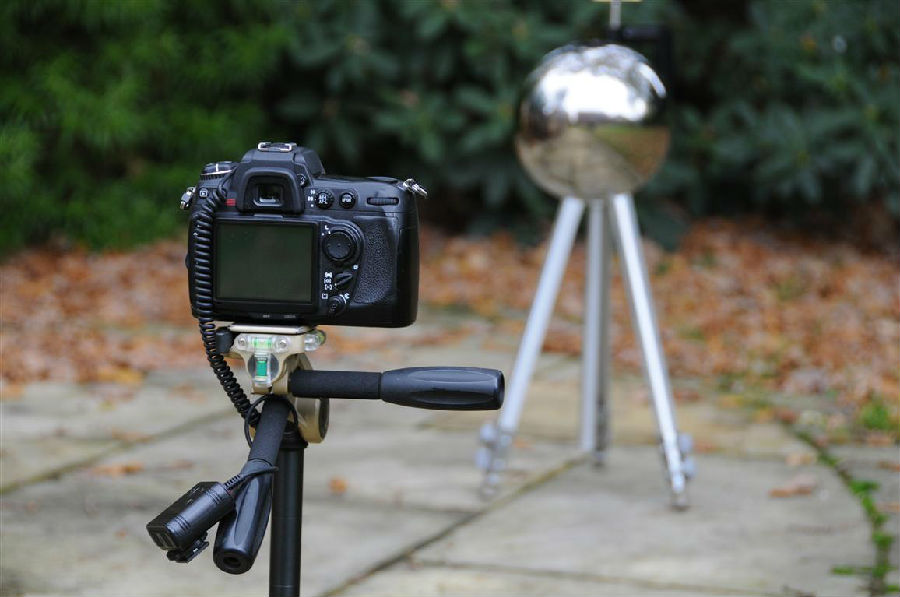Getting an accurate HDRI really quickly is what causes all that scrambling on shoot days.
获得准确的HDRI真的很快,这使得拍摄日陷入了一团混乱。
The first HDRIs actually used stuff like this: gazing balls, Christmas ornaments, anything that was round and shiny and could help them get a panorama.
第一批HDRI实际上使用了这些东西:凝视球、圣诞装饰品、圆形和闪亮的东西,这都可以帮助他们获得全景。
The idea is that the picture of the gazing ball gets unwrapped into a 360 degree picture when you put it in the right software.
当你将其放入正确的软件时,凝视球的图片会延展成360度的图片。
I'm going to start taking some photos and that's going to help us capture all the light in the scene and get it in this panorama.
我要开始拍一些照片,这将有助于我们捕捉场景中的所有光线,并在这张全景图中得到它。
This reflective ball is one of three main ways that people do it.
这种反光球是人们使用的三种主要方式之一。
Sometimes people will rotate their camera or use a lens that's really wide.
有时人们会旋转摄影机或使用非常宽的镜头。
VFX supervisors like Leo might also use a 360 degree camera to snag these images really quickly because they're in the middle of a hectic situation.
像里奥这样的视觉特效主管可能也会使用360度摄像头快速捕捉这些图像,因为他们正处于忙碌的状态。
I use the Theta. It's a 360 camera and it's very small. So it's not intrusive.
我用Theta全景相机,这是一个360度的小相机,所以它不是侵入性的。
With the Theta, usually it's a couple of seconds if you're doing a chrome ball.
有了Theta,如果你在用一个镀铬球的话,通常需要几秒钟。
So you have to set up a tripod, you have to put the ball down. That's a couple of minutes.
你得搭个三脚架,把球放下,这需要几分钟。
This is where the Theta makes all the difference in the world because it's such a tiny device and you just plop it down and you get in and get out.
这就是Theta全景相机产生巨大差异的地方,因为它是一个如此微小的装置,你只要把它砰的一声放下,你就可以进出。
When I'm just shooting bracketed with the eight millimeter lens, probably a minute.
当我用八毫米镜头拍摄的时候,大概需要一分钟。
Right between takes I get in and I do as much as I can and then I get out of there.
就在拍摄中间,我尽我所能地进入,然后离开那里。
HDR is so mainstream now that I can plop it into editing software and make an HDR photo.
HDR现在是如此主流,以至于我可以把它放到编辑软件中,制作一张HDR照片。

I took some video without the chrome ball in it, so I put my 3D image in there.
我拍了一些没有镀铬球的视频,我把我的3D图像放进去了。
You see, without the light, it looks fake.
你看,没有灯光,它看起来就很假。
Add the HDRI though, and boom, suddenly it's like it's there.
加上HDRI,砰,突然就好像它在那里一样。
Do you see the reflection of the trees or how the sun is glinting off of it?
你看到树的倒影了吗?或者太阳光是如何从树上照下来的?
Using a real environment to light a 3-D object started with work like this teapot.
使用一个真实的环境来照亮一个三维物体始于像这个茶壶这样的工作。
See the windows reflecting in it?
看到窗户反射进来光了吗?
In the 90s, researcher Paul Debevec and colleagues pioneered the creation of HDRIs from multiple images and then using those to light 3D scenes.
在90年代,研究人员保罗·德贝维奇和同事们率先从多幅图像中创建了HDRI,然后用这些图像来照亮3D场景。
Without them, back in the late 90s, it was a lot harder.
如果90年代末没有他们的话,情况就大不相同了。
As his paper says, currently available techniques for realistically rendering synthetic objects into scenes are labor intensive and not always successful.
正如他的论文所写道的那样,目前可用的将合成物体真实地渲染到场景中的技术是劳动密集型的,并不总是成功的。
They had to position lights, copy reference photos and program in reflections.
他们必须定位灯光,复制参考照片并在反射中编程。
People still have to do some of that. But you can also let HDRI light objects in your scene.
人们还得做一些事情,但你也可以让HDRI照亮场景中的对象。
Today, repositories of HDRIs let you download images and simulate thousands of environments, like an old room or outside a small cathedral.
如今,HDRI的存储库可以让你下载图像并模拟成千上万的环境,比如一个旧房间或一个小教堂外。
This lighting often still comes from a ball like this one, but VFX artists don't use that extra time just to chill out. They used to work harder.
这种照明通常还是来自这样一个球,但视觉特效艺术家不会把多出来的时间用来休息,他们会更加努力工作。
As a person who's thinking about light like exponentially more than the normal person, would you rather hang out with Rembrandt or Newton?
作为一个对光的思考比普通人高出一倍的人,你更愿意和伦勃朗还是牛顿在一起?
Maybe Rembrandt, but ultimately, if I if I threw another name in there, it would be Degas.
也许是伦勃朗,但最终如果让我再加上一个名字,那就是德加。
Why Degas? Because he was just obsessive about his artwork, him constantly chasing perfection is something that I think drives a lot of artists and also intrigues me at the same time.
为什么是德加?因为他痴迷于自己的作品,他不断追求完美,我认为这给很多艺术家注入了动力,同时也吸引了我。












